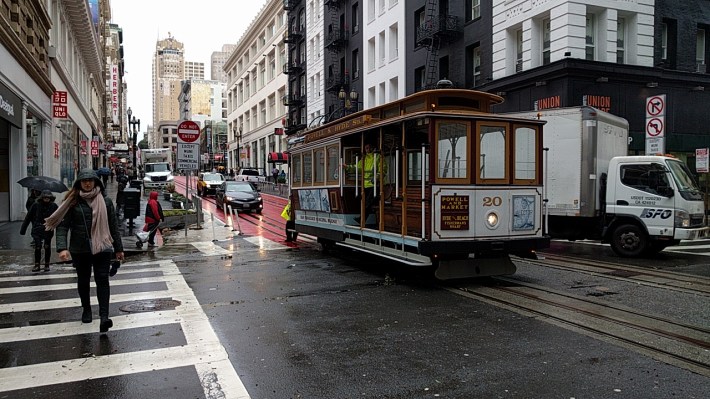
The SFMTA Board passed a partial rollback this afternoon of the “Powell Street Safety & Improvement Pilot,” an 18-month test project to evaluate banning private vehicles on the particularly busy stretch of Powell Street between Ellis and Geary.
The change, based on staff recommendations, took a plan that reserved the street for “Muni, paratransit, taxis and commercial vehicles only” and changed it to also allow private vehicles "picking up or dropping off passengers at the loading zone in front of 230 Powell Street.” Nicole Ferrara, Executive Director of Walk San Francisco, said it will be impossible to enforce that private cars are only loading at that location and not driving through. "You can't have a cop there all the time. It undoes what the pilot did and is pretty disappointing." The decision was part of SFMTA's “consent calendar,” meaning it was passed without discussion or a vote.
It was only last December that the city started the pilot. Given that Powell--between the cable cars, delivery trucks, taxis and private automobiles--was a virtual parking lot, safe-street advocates have long argued that the street should be transformed into a transit and pedestrian promenade. Powell doesn't even connect to Market Street, since the southernmost block was turned into a plaza in 1973. As a result, drivers end up doing u-turns, further jamming up the street. It's also a concern for maintaining San Francisco's iconic cable cars, which aren't able to handle stop-and-go traffic, because it wears out and frays the cables.
Either way, it should be self-evident that there's no room for private cars on this stretch of street, just from looking at photographs from past issues of this publication and others. And SFMTA is trying to reduce the number of cars through incremental changes. For example, in 2011, all parking was removed from Powell south of Geary. But not everyone is keen on getting cars off of this stretch of Powell.
"Several Powell Street property owners came forward and asked that we also include the northbound side of the street [accessible to private vehicles] as a condition of their support for the project legislation," explained Paul Rose, a spokesman for SFMTA. "Staff agreed to this change, and the Board directed staff to return in January with the requested modification, as long as staff was confident that the 'less restriction' regulation would still achieve the pilot goals."
“Our role in this process was to convene stakeholders that would be impacted by the change,” wrote
Union Square Business Improvement District (BID) Executive Director Karin Flood. "In the case of Powell Street we had to balance the need to accommodate the large number of pedestrians walking up Powell with the loading and unloading needs of the individual hotels and merchants.”
Safe street advocates, meanwhile, were frustrated. “It's pretty disappointing to see this street opened up to private vehicles again without a complete evaluation of the pilot program,” said Ferrara. “This will impact pedestrian safety.”
“This is a really old system,” explained a cable car conductor on Powell who asked Streetsblog to withhold his name. He motioned to a cable car he just helped push across Ellis. “It's much better, much safer with the street closed [to private cars].”




